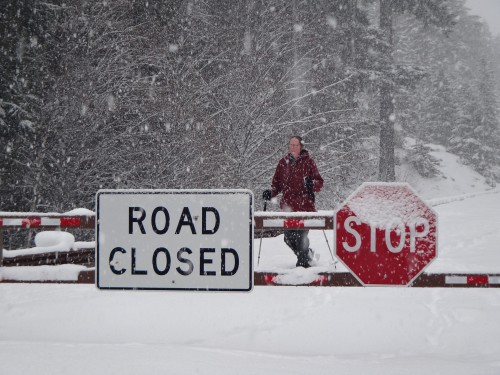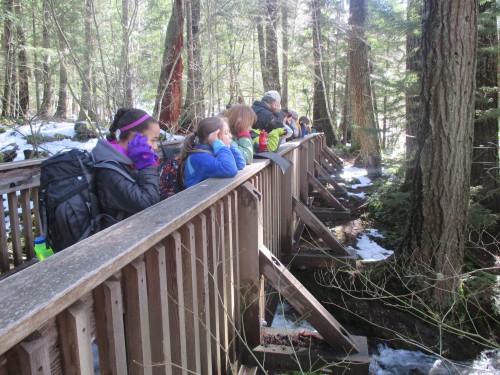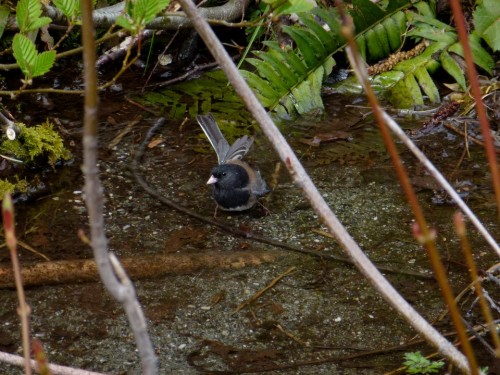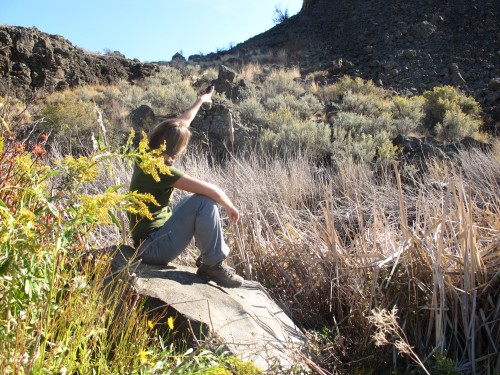Quietude

Highway 20 opened last Thursday at noon after six months of being closed — as it is every winter, due to heavy snows and avalanche danger over the pass — between Milepost 134 at Ross Lake and Milepost 178 at the Early Winters Information Center. This year, it took clearing crews almost six weeks to move the snow that had fallen up to 35 feet deep. The opening is a cause for celebration: East side, we’ve missed you! Yet there is also a tinge of lamentation, for the “road closed” season is a unique time in the North Cascades, one characterized by near impeccable silence.
Though those of us at the Environmental Learning Center live, work and play in a remote, backcountry national park, the effects of May through November’s steady stream of vehicular traffic on the acoustic environment is hard to ignore. Through the winter, residents and visitors hear the rhythm of the rain and the schulumps of snow sliding from needled branches above. As we orbit into spring, the sounds of nature change. The road closure’s sustained quiet is perfectly timed with the re-arrival of migrating birds, and the clean air is enlivened with the complicated call of Pacific Wrens, the monkey-like laughter and jackhammering of Pileated Woodpeckers and the dive-bomb buzzing of Rufous Hummingbirds.
The absence of murmurings from internal combustion engines offers the opportunity for a heightened level of sensory awareness, whether to auditorily observe the Park with adult ears or to facilitate listening activities for Mountain School students. “What’s the quietest sound you can hear?” instructors often ask trail groups. What about the fir cone scales gnawed away and dropped in a pile by industrious Douglas squirrels, or the various sounds water makes as it flows and dribbles and pools over the landscape? The cracking of a bud’s petals or the birth of a baby bird? “Road Closure” time is the ideal season for “sound mapping,” as well: Choose a spot to sit with pencil and paper, draw an “X” in the middle representing yourself, then listen and draw what you hear, notating it on the page in relation to your sit spot.
 Fifth graders from Bellingham’s Wade King Elementary using their “deer ears” to better hear the sounds of nature along the Deer Creek bridge. Photo by Molly Foote.
Fifth graders from Bellingham’s Wade King Elementary using their “deer ears” to better hear the sounds of nature along the Deer Creek bridge. Photo by Molly Foote.
It is typically trying-slash-impossible to convince trail groups of ten fifth graders to close their mouths for any significant stretch of time with the goal of really listening (and the amount of talking and enforcing that trail instructors usually have to do toward such ends makes these attempts rather ironic). But the forest is a busy place; when one’s ears are opened and the machines given a rest, this becomes immediately apparent, sometimes to the point of epiphany.
Even without Highway 20 traffic, though, we are never far from reminders of the pace, size and sonic magnitude of contemporary existence. Many years ago, I spent 48-hours on a wilderness “solo” near the Dirty Devil River in Utah. While I sunned on slickrock, battling beefy ants and timing my day by the pale pink evening primroses that opened with the setting sun, I also became quickly acquainted with the flight paths of commercial jets. Respite from reminders of human civilization — the subtle or the bludgeoning — are hard to come by these days.
So difficult that Gordon Hempton, a western Washington-based acoustic ecologist, believes there may be fewer than a dozen places left in the United States where one can be for 20 minutes without hearing noise from human activity. He bases his argument, in part, upon his extensive listening experience, including a cross-country “sound tracking” tour in 2010, after which he co-authored One Square Inch of Silence: One Man’s Quest to Preserve Quiet (Free Press/Simon & Schuster, 2010). “It is our birthright to listen, quietly and undisturbed, to the natural environment and take whatever meanings we may from it,” Hempton writes on his website. “By listening to natural silence, we feel connected to the land, to our evolutionary past, and to ourselves.”
 Can you hear this Dark-Eyed Junco taking a bath? Photo by Alex Patia.
Can you hear this Dark-Eyed Junco taking a bath? Photo by Alex Patia.
Hempton also founded “One Square Inch,” an independent research project located in the Hoh Rain Forest of Olympic National Park. Here he has identified – you guessed it – one tiny spot entirely free of noise pollution. It is marked by a small, red-colored stone that was given to him by an elder of the Native American Quileute tribe and is now placed atop a mossy log. The idea is that since a loud noise, such as that of a passing aircraft, impacts several of the surrounding square miles, designating a noise-free space, even one just the size of a postage stamp, with have its own rippling effects.
Ironically, one can find directions to this project on the “One Square Inch” website. (the exact coordinates are 47° 51.959N, 123° 52.221W). How long will this acoustically pristine site maintain its quietude as listening hikers pay homage? The scritchy scratch of synthetic hiking pants, the vocal appreciations of friends on trail, the beep of some technology one forget to turn off? A worthy conundrum, indeed.
Noise pollution has become a noted environmental issue over the past couple of decades. Not only do some humans seek solace away from anthropogenic noise, but it is critical for wildlife who depend on auditory signals for survival functions such as feeding, migration and breeding to not be bombarded with extraneous sounds. As Hempton said in a 2010 interview in The Sun: “The problem is that humans are often oblivious to the natural balance of sounds that has been established since the beginning of time. Imagine we’re gathered to hear a symphony, and a handful of people are running vacuum cleaners or perhaps playing their own instruments without any regard to the orchestra. That’s how human sounds often come across in a wilderness environment.”
Where is the quietest place you can think of? What are the sounds that impact it? Is it secure in its silence, or threatened? What are your favorite sounds?
As I join the party and drive to the east side, revisiting my favorite places in the Methow Valley, I’ll remember to consider my own contributions to the acoustic ecology, and try to open my ears ever wider to catch nature’s callings over the clamoring cars.
 The author on the east side in the fall, demonstrating how to communicate the presence of something especially cool in nature without making a sound. Photo by Elissa Kobrin.
The author on the east side in the fall, demonstrating how to communicate the presence of something especially cool in nature without making a sound. Photo by Elissa Kobrin.
Leading photo: Sheri Harter explores the closed side of a wintertime Highway 20 on snowshoes. Photo by John Harter.
Katherine Renz is a graduate student in North Cascades Institute and Western Washington University’s M.Ed. program. She likes to Enjoy the Silence: All I ever wanted/All I ever needed/Is here/In my arms.

